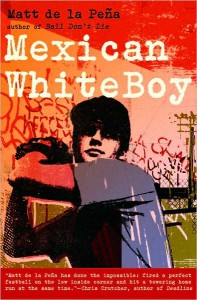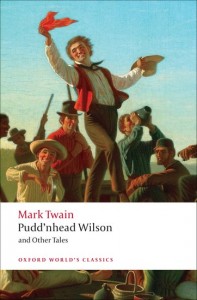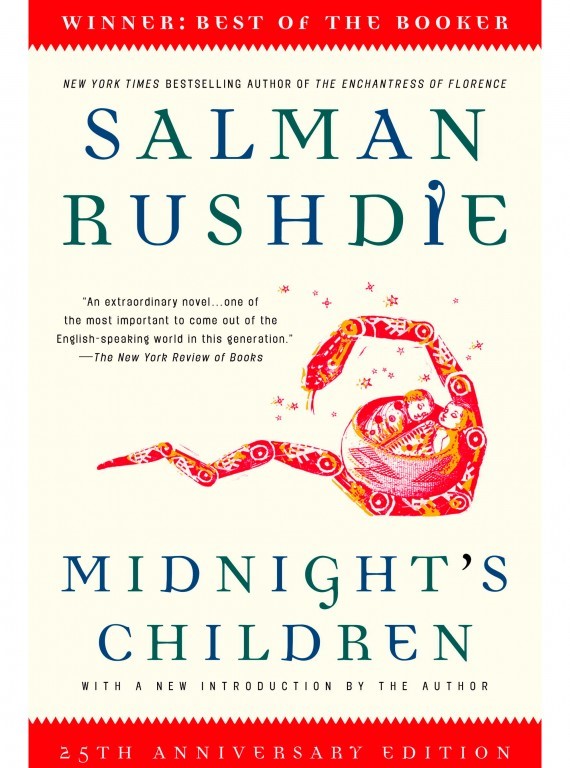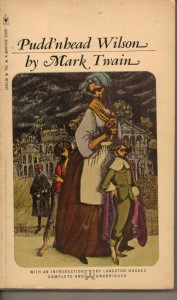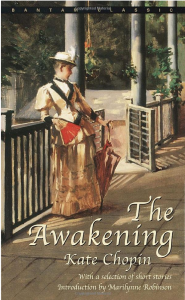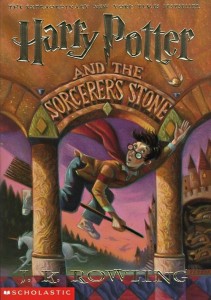Jazmine Dubois
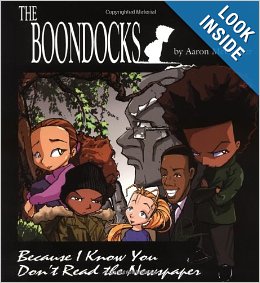
Character: Jazmine Dubois
Source Text: McGruder, Aaron. Boondocks: Because I Know You Don’t Read Yhe Newspaper
Entry Author: David Lwamugira
Aaron McGruder’s highly intelligent and racially charged comic strip, the Boondocks, provides readers some insight into the thinking of a pair of African American youths named, Huey and Riley, who must navigate their way through a mostly white society. The neighbor of these characters , Jazmine, acts a literal bridge between the two worlds because she has a black father and a white mother. During Jazmine’s first interaction with Huey, Huey tells her, much to her despair, that “it’s good to have more black people around.” Jazmine disputes the fact she is black and asks Huey why he would assume what race she was. Huey responds by saying, “Well first of all, Mariah, your afro is bigger than mine.” When she responds with, “I don’t have an afro – my hair is just a little frizzy today,” Huey retorts: “Angela Davis’ hair was ‘a little frizzy.’ you have an afro.” Jazmine then screams in protest, “I DO NOT and who is Angela Davis?” Huey compares Jazmine to Angela Davis, an African American political activist who took part in the Civil Rights movement and she fails to catch the reference. This shows that Jazmine has the physical appearance of an African American but does not fully identify herself as a member of the community, as well as the gap in historical knowledge between Huey, an African American, and Jazmine, a member of both the White and African American communities.
Jazmine’s identity is constantly being determined by others. When asked by a school questionnaire what race or ethnicity Jazmine belongs to, Jazmine leaves the field blank. The elementary school principal calls Jazmine’s mother in order to get a straight answer and she says it’s up to Jazmine to construct her own identity: “We don’t want anyone doing that for her. Is that clear? If she must be called anything, use the term ‘multiracial.’ Never ‘white,’ never ‘black.’ Ok?” Immediately after this speech, the principal decides to ignore her mother’s advice and identify Jazmine as an African American. So many people in this world ignore the fact Jazmine is a mixture of races. By defining her as one or the other, they limit her growth as a person.
In a moment of desperation, Jazmine expresses her feelings in a very open and honest manner that captures the experience of being biracial:Most people don’t understand what its like being different. Like…I once saw a yellow flower right in the middle of a bunch of red roses…everything around it was either green or red, and here was this yellow flower. It looked lonely. That’s what it’s like being biracial. I’m different from everyone else. My mom and dad say that makes me special, but i just think it’s lonely. (McGruder 27)
Her soliloquy shows the reader she is just a young girl trying to find acceptance in a world where defining someone’s race can still mean defining their character. Jazmine wants to live her life free of judgment or the pressure to choose which race she shall identify with. Yet the notion of belonging to one race or another matters much more to her peers than it does to her. Like any human being, Jazmine wants to be treated with decency and respect.
Danny Lopez
Character: Danny Lopez
Source Text: De La Pena, Matt. Mexican White Boy. New York: Delacorte Press, 2008. Print.
Entry Author: James Tyler
Sixteen-year-old Danny Lopez is half-Mexican and lives in comfortable San Diego county; the son of a white mother and an absent father, who walked out on the family when he was a child. Confused over the concept of his own identity, he wonders why his father left the family for Mexico and whether the motivation involved embarrassment over having a biracial son. The novel follows Danny’s experiences on a visit to National City, Mexico, in search of his biological father in Ensenada.
The only other Hispanics Danny has any familiarity with are Mexican people who “do under-the-table yard work and hide out in the hills because they’re in San Diego illegally” (De La Pena, 2). As much as Danny feels like an outsider being a biracial American in San Diego, he feels equally out of sorts in National City, if not more, because he is not fluent in the Spanish language. And, what’s more, not only is he described as “a shade darker than all the white kids at his private school,” but whenever he comes to National City, “where his dad grew up, where all his aunts and uncles and cousins still live – he feels pale. A full shade lighter. Albino almost” (De La Pena, 3).
Hispanics/Latinos are the fastest growing minority within the United States and are expected to constitute a sound majority within several generations, so much so that political scientists have labeled the demographic, “the sleeping giant.” As such, it is almost impossible to define such a demographically diverse population within one subgroup. Class, Nationality, Ethnicity, Biological Race, Politics, and Culture/Language all factor into the definition of what it means to be a Hispanic/Latino. As such, the identity crisis experience by Danny is not at all surprising or unusual.
The literary device De La Pena employs which symbolically unites such a diverse group is Basebal. A skilled pitcher, Danny has a proportionately difficult time succeeding in his favorite sport, as much as he has trouble straightening out his identity conflict, because despite his talent, he is cut from the Baseball team over his lack of focus. But, his first moment of true belonging in Mexico comes while observing the Mexican kids playing Baseball. “He’d give anything to be out there playing instead of standing here watching,” De La Pena writes. “Nobody plays stickball in Leucadia. Why don’t the white kids play stickball? He wonders. Maybe because they have real baseball fields…Or maybe they’ve just never thought of it.” This moment is also how he comes into contact with his first close Mexican friend, the half-black “negrito,” Uno, even if his first contact with Uno is by getting knocked out.
As a Hispanic-American who was raised in a predominantly white suburban environment, the individual obstacles presented to Danny Lopez, in terms of identity exploration, were so readily identifiable to me that at times it was frightening. De La Pena very well could have gone the traditional route of making Danny the stereotypical “angry half-breed” full of a frustration he can only express in brute violence. On the contrary, Danny Lopez is not only a sensitive character, but a startlingly troubled one, who takes his frustration out on himself. From the beginning the near-mute Danny is struggling with a form of Depression, which he copes with by cutting his wrists. While I have never reached this level of emotional depravity, the conveyed feeling of being “between worlds,” due to language barriers, skin color, or class differences, is such a familiar, relatable emotion that someone being led to that form of self-abuse by it is almost unsurprising to me. With any luck, novels such as this will encourage a greater dialogue and discourse regarding teens with mixed identities and the challenges they face, so that such heartbreaking self-harm will be a thing of the past.
Roxy
Character: Roxanna
Source Text: Twain, Mark, and R. D. Gooder. Pudd’nhead Wilson and Other Tales. Oxford [England: Oxford UP, 1992. Print.
Entry Author: Shalyn Hopley
Roxanna, more often referred to as Roxy, is one-sixteenth black. Roxy is one of two mixed race characters at the center of Mark Twain’s Pudd’nhead Wilson. Roxy is a slave, but “to all intents and purposes Roxy was as white as anybody, but her one sixteenth of her which was black outvoted the other fifteen parts and made her a negro,” (Twain 8). She is described as looking as white, but her mannerisms are fitting of a black slave. Roxy is the caretaker for two boys, her own son and the white son of her masters. Both children are indistinguishable without clothing by the master of the house. Roxy’s actions regarding the children are central to the plot of Twain’s novella. In a fit of panic about the possibility of her own child being sold “down the river”, Roxy decides to kill herself and her child. Before carrying out the act, she dressed both herself and her son in their finest clothing. Upon seeing her child, she realizes she can switch the children, which she does, and pass her son off as the master. The children, Tom, the master’s son, and Chambers, her own child, are given each other identities in infancy and it is this action that carries the novel forward.
Roxy is a complicated character, drawn complexly at the center of the complications of an illogical system of blood. Roxy eventually is freed by her master Driscoll and works her own way on a river boat. She watches Tom, who was originally Chambers, grow into a spoiled child who scorns her. She reveals to Tom his heritage, and they together concoct schemes, yet she is still betrayed by Tom who sells her back into slavery down the river. While Roxy’s actions are revolutionary and challenge the status quo on face value, they ultimately are problematic. Firstly her actions are not openly defiant, nor are they the most ethical. Her switch is like an “eye for an eye,” a child for a child. She condemns Chambers to a life of slavery and the possibility of being sold down the river. While she subverts the system by having a “black” child in the position of master and a white child in the position of slave, she has not found a means to truly affect change. She has made one individual change while the system remains intact. Additionally, her actions are ultimately righted with disastrous consequences for all involved. Tom is condemned to slavery, sold to the men to whom he owed gambling debts; Chambers rises into a class he is unable to fit into due to his upbringing; Roxy’s heart was broken by the misfortunes that have befallen her son and the child she condemned to slavery. Roxy may try to challenge the status quo in Dawson’s Landing but she is not successful, her actions producing no victories, the system of blood continued.
Saleem Sinai
Character: Saleem Sinai
Source Text: Rushdie, Salman. Midnight’s Children. 25th Anniversary ed. New York: Random House, 2006. .
Entry Author: Shalyn Hopley
Roxana
Character: Roxana
Source Text: Mark Twain, Pudd’nhead Wilson and those Extraordinary Twins (1894)
Entry Author:
Roxana is a slave woman. Over many years of racial mixing in her ancestry, she no
longer appears black, the 1/16 portion remaining no longer expressing itself. To
outside observers she is white, “of majestic form and stature, her attitudes were
imposing and statuesque, and her gestures and movements distinguished by a noble
and stately grace.”(9) It is interesting to note that her white skin allows her the
agency to switch her children, an act that would denied to a black skinned black
person. Black skinned characters do not appear to have the ability to exercise
agency in any meaningful way of their own. It is only when she is heard speaking
that those who do not know her understand that she is a slave and is black. She
considers herself to be black as well, and does not find that particularly odd. She is a
nurse maid to the children of Mr. Driscoll, as well as having a child herself. She
switches her child with the child of the Driscoll’s so that he may grow up to be a free
man. Other slaves around her recognize her to be a black person. They react to her
easily as a member of their community. (9) Although Roxy is unable to pass for white
because of her speech habits, which mark her as a member of the slave caste, she
recognizes that because her master is unable to distinguish between the two
children, that she would be able to free her son from a lifetime of bondage by
exchanging him with the son of her master. This demonstrates that Roxana
understands that race is only skin deep. She doesn’t see a reason that her son
couldn’t take the place of a white boy if he looks the same. The conventions of black
inferiority do not seem to have worked themselves into her head completely. If she is
able to switch the roles of her children by switching their places, they should be able
to function in their new positions well. Unfortunately this belief that the character of
whites and blacks is fundamentally the same is untrue for her, and her child behaves
very poorly. But this is not because he is black, but because he is a product of his
environment. Like Roxy, who is white in appearance but raised and acts black, her
child raised as a spoiled white boy acts like one. Roxy is unable to take great
measures to enact her own freedom, like running for her life, she does find a way to
reclaim some power through the exchange of her child. Ultimately, Roxana
demonstrates that the character of a person is determined by their upbringing and
social status, not by the genes which they carry. Although the nature and nurture
debate is cast into a strange new realm today, where genetics are beginning to be
found to be responsible for some elements of a persons behavior, at least
pathologically, Roxana is a representative of a train of though which states that all
human behavior is rooted in nurture.
Roxanne
Character: Roxanna
Source Text: Twain, Mark, and Sidney E. Berger. Pudd’nhead Wilson and Those Extraordinary Twins: An Authoritative Text, Textual Notes, Criticism. New York: Norton, 1980. Print.
Entry Author: Claire Tierney
Roxy is 1/16th black and 15/16ths white in Mark Twain’s Pudd’nhead Wilson, where she is a slave to Percy Driscoll. She is resilient, resourceful, and pragmatic. She is very much a victim of her society and her station in life. She is described as looking white, “to all intents and purposes Roxy was as white as anybody; but the one.sixteenth of her which was black out-voted the other fifteen parts and made her a negro” (9).
She is described as beautiful, “Her complexion was very fair” and her hair was brown, “but it was not apparent because her head was bound about with a checkered handkerchief and the hair was concealed under it” (9). When she is “among her own caste” she had “an easy, independent carriage […] and a high and ‘sassy’ way” (9). But when she was around white people she was “meek and humble” (9). Society defines her as black only because of her tattered clothing and lower-class vernacular. These social constructions, along with her intellect and strength, highlight the fallaciousness of Dawson’s Landing’s definitions of race.
Her sense of morality is constantly in question. Early on the novel when she sees Judge Driscoll has left some money out, she does not take it, thanking the fact that she “was saved in the nick of time by a revival”, saying “‘Dad blame dat revival, I wist it had a ben put off till tomorrow” (12). Later on in the novel her only concern becomes protecting herself and her son. She is willing to do anything for him. She complicates the binary of good and evil, and becomes increasingly darker throughout the novel. This is a direct result of desperation, as she is forced to make decisions more erratically.
She switches Tom and Chambers in their infancy in an effort to save her son the pain of serving the same life sentence of slavery that she has endured. Nevertheless, she enjoys seeing her son, a black man, in a position of power. She actively seeks to change the status quo in her society, and uses her and her son’s multiraciality to do so.
Later when the death of Judge Driscoll frees Roxy, she works hard until her body is arthritic, and she comes back to see her son. She becomes enraged when she sees that her son has become a criminal, squandering the opportunity she gave him by falling prey to society’s spoiling of him. She takes control of his life, demanding that he turn over a part of his allowance to her. She masterminds criminal plans with her son, and he betrays her, selling her “down the river” to an abusive slave master. She escapes by attacking her overseer and returns to Tom, telling him that she will reveal his true identity as a black man if he does not buy her freedom. After Tom fails at doing this, and gets caught in the Murder of Judge Driscoll, Roxy lives the duration of her life with “the spirit in her eye quenched” and “the voice of her laughter ceased in the land” (120). She fulfills the prophecy of the tragic mulatto, forever an outcast to society, forever miserable.
Roxy comports herself with confidence as a beautiful light-skinned woman around black people, and as a lowly ignorant black woman among white people. Her presentation, her vernacular, and even her morality are largely defined by the perceptions of those around her, more than how she defines herself. Despite her pragmatism and attempts at disrupting the status quo, she falls victim to society’s cruel logic.
Armand Aubigny
Source Text: Chopin, Kate. The Awakening: With a Selection of Short Stories. 1899. Reprint. New York City: Bantam Dell, 1981. 177-182. Print.
Entry Author: Emma Baker
In Kate Chopin’s short story, “Desiree’s Baby,” Armand Aubigny is the father of the titular child and the husband of Desiree. Belonging to a well-known, respectable Creole family, he owns a plantation called L’Abri that he inherited from his father. He spent his childhood in Paris until his mother’s death, and returned home to the United States with his father. Presumably, he lived with his mother when she was still alive. His role in the short story focuses on falling in love with Desiree, the adopted daughter of the Valmondés, another well-known creole family. Although Desiree comes from an ‘obscure origin,’ as the Valmondés found her around the ‘toddling age’ near the gateway to their home, Armand initially finds that no obstacle to marriage instead asserting, “What did it matter about a name when he could give her one of the oldest and proudest in Louisiana?” However, while his father treated the slaves under his ownership with kindness, “Young Aubigny’s rule was a strict one, too, and under it his negroes had forgotten how to be gay.” (Chopin, 177)
As such, Chopin positions Armand Aubigny as the character with the most power in his societal context. He is male, wealthy, and at the start of the story, both the reader and the surrounding characters believe he is white. One can see evidence of his exercise of this power in the treatment of his slaves as well as evidence of prejudice and racism. He seems reasonable in his acceptance of a nameless wife whose origins are unknown at the start of the novel, but after the birth of their child one perceives changes in his behavior. Others notice the child’s skin tone before he does but he begins to absent “himself from home; and when there, avoided [Desiree’s] presence and that of her child, without excuse.” (Chopin, 179) After Desiree herself realizes the similarity to one of the quadroon boys of La Blanche, a mulatto slave, she pleads with Armand to tell her what it means. He only responds, “it means…that the child is not white; it means that you are not white.” (Chopin, 180) Armand is not suspected to be the reason for the child’s quadroon appearance, as Desiree’s origin is unknown. As she attempts to defend herself by naming her features, he cruelly responds, “As white as La Blanche,” (Chopin, 180) demonstrating that the physical appearance of whiteness holds no power when one carries ‘black blood.’ Following this, he draws further away from his wife, begins to treat his slaves with a greater cruelty than before and does not prevent his wife from walking unprotected into the bayou with her child never to return. His position in a place of power demonstrates how influential his actions and decisions are on the lives of others around him, as well as highlight the discrepancy between an unknown origin or namelessness and the possibility of having black ancestry.
Chopin does not reveal his parentage until the last lines of the story. As he burns all of Desiree’s belongings he finds a letter sent from his mother to his father saying, “I thank the good God for having so arranged our lives that our dear Armand will never know that his mother, who adores him, belongs to the race that is cursed with the brand of slavery.” (Chopin, 182) The reader then retroactively remembers various mentions throughout the story of “Armand’s dark, handsome face,” (Chopin, 179) and when Desiree pleads, “look at my hand; whiter than yours, Armand.” (Chopin, 180) As such, Chopin constructs Armand as a mixed race character who passes for white and maintains, if not enforces, the status quo in order to demonstrate the hypocrisy of the Louisiana culture. In the revelation of his mixed race as the final and pivotal plot-point, Chopin upsets the status quo by suggesting a complete lack of adherence throughout the piece, as well as emphasizing the dire consequences that resulted from adherence to those conventions.
Saleem Sinai
Character: Saleem Sinai
Source Text: Rushdie, Salman. Midnight’s Children. 25th Anniversary ed. New York: Random House, 2006. .
Entry Author: Shalyn Hopley
Saleem Sinai is the illegitimate son of William Methwold, a white British officer, and Vanita, a poor Indian street performer’s wife. However, Saleem is born at the same moment as Shiva, the son of Amhed and Amina Sinai, a wealthy Kashmiri family moved to Bombay. Shiva and Saleem are switched at birth by Mary Pereira, and Saleem is raised as the Sinai’s son without them knowing. Saleem is the protagonist and narrator of Midnight’s Children yet his birth and the revelation of his mixed race heritage do not occur until about a fifth of the way through the book. The beginning portion of his story is spent describing his family history. Yet with Saleem’s birth, the audience discovers that this history is not that of his biological family but that of his unwitting adoptive family. Rather than tell the story of his poor Indian mother, his colonizing British father, and their extra-marital affair, he has chosen to tell the story of his Kashmiri family. Saleem interestingly acknowledges his mixed-race heritage and gives it a significant place in the story, including its revelation during one of the turning points of the novel—his birth, which coincides with the partition of Indian and Indian independence (132); still while acknowledging his mixed race parentage, he is privileging a monoracial identity and even discounting the significance of his parentage saying “…there’s something more important than that. It’s this: when we eventually discovered the crime of Mary Pereira, we all found that it made no difference! I was still their son: they remained my parents.” (131).Saleem’s mixed birth however cannot be so easily discounted in the significance to the story. Saleem’s status as a mixed race character and child who not truly his parent’s child is symbolic of the status of India at the time of his birth. He is the result of colonization, and evidence of an Indian divided by foreign powers who are on their way out. He speaks of himself and the other midnight’s children, “children were being born who were only partially the offspring of their parents—the children of midnight where also the children of the time: fathered, you understand, by history.” Saleem, and his mixed heritage, becomes central to Rushdie’s allegorical tale of Indian independence.Saleem and his fellow Midnight’s children usher in a new period in India’s history, and in the novel, are granted with special abilities which destine them to stand out in both society and history. Much of Saleem’s personal history is interwoven with Indian history, his action being key to some of the wars in India. Eventually, his existence and that of his cohorts becomes central to Indira Gandhi’s Emergency. She declares the state of Emergency to imprison and sterilize the midnight’s children, draining them not only of their reproductive abilities but their magical abilities and their hope (505). Her actions are tinged with a dark history of sterilizing the racial other, the undesirable elements of society so they and their progeny can no longer contribute to society. The power of the midnight’s children is intrinsically tied to their ability to reproduce, and so without powers and their ability to have children, they cannot affect the story of India. No longer connected to history, Saleem begins to fall apart, supposedly literally disintegrating at the young age of thirty-one.
Antoinette Cosway
Character: Antoinette Cosway
Source Text: Rhys, Jean. Wide Sargasso Sea. New York: W. W. Norton &, 1998. Print. Norton Critical Edition.
Entry Author: Lauren Cyr
Antoinette and her mother are unable to fit in with the other white people in Jamaica. This is due to the fact that they are from Martinique originally, a French colony, rather than the Jamaican English colony. Antoinette is, however, also unable to relate to the non-white villagers as well. The villagers refer to Antoinette as “white cockroach,” in reference to her creole/white race. Antoinette is also the daughter of a former plantation owner; her class sets her apart from the other slaves.
Antoinette’s European heritage puts her into contact with her eventual husband, Mr. Rochester, a white man from England. He comes to Jamaica in order to marry Antoinette. He continually tries to subdue the Creole side of her, which he associates with madness. For example, he decides to rename Antoinette (her mother’s Creole name) “Bertha,” a more English sounding one.
In addition to changing her name, Rochester also seeks to change Antoinette’s language, further fragmenting her identity. Antoinette’s language contains remnants of her Creole heritage, a heritage that Rochester believes to be inferior. When Antoinette speaks to him, Rochester is reminded of her “inferior” background. To him, not only is Antoinette Creole, she is also the wrong type of Creole. When Antoinette speaks, she does so by “chattering in patois,” the patios a blend of the language of the colonizing with the colonized. Antoinette’s heritage stems from Martinique, a country colonized by the French. Thus her language is a combination of French and a native tongue, twice removed from Rochester’s English.
Rochester devises a plan to move Antoinette to England, in order to further suppress her Creole heritage. In a move that symbolizes the influence of white English men over the Caribbean people, Rochester takes ultimate control of Antoinette by locking her in attic for the rest of her life. He sees Antoinette as a source of madness, and hopes that by locking her away in England, he will be able to put her aside and forget about her. Antoinette is rejected by the blacks on the island for being too white, and by her husband for being too Creole. Her fragmented identity and struggle for finding a sense of place leads to her eventual madness at the end of the novel.
Harry Potter
Character: Harry Potter
Source Text: Rowling, J.K. Harry Potter Series. New York: Scholastic, 1998-2007. Print.
Entry Author: Jessica Davis
“Mudblood is a really foul name for someone who was Muggle-born – you know, non-magical parents. There are some wizards – like Malfoy’s family – who think they’re better than everyone else because they’re what people call pure-blood… I mean, the rest of us know it doesn’t make any difference at all” (Rowling, Chamber of Secrets, 89).
Mudblood is a sort of racial term describing a witch or wizard born to two muggle parents, describing their blood as filthy.
One of the most profound advocates for equal rights of blood status, is Albus Dumbledore. He is a constant reminder in the series to treat people equally, and never judge them based on where they come from or what they may be.
“You place too much importance, and you always have done, on the so-called purity of blood! You fail to recognize that it matters not what someone is born, but what they grow to be!” (Rowling, Goblet of Fire, 708).
This sort of stance is what Rowling is trying to teach her readers that differences mean nothing to those with open minds and a willingness to accept others. The pureness of a witch or wizard’s blood is thought to keep magical ability within magical families, but magic can be passed down even through muggle families.
Ironically, Harry’s half-blood status is one of the greatest plot movers, since Lord Voldemort uses this fact to choose Harry as his eventual downfall, due to a prophecy. The choice is between Harry the half-blood, and Neville Longbottom, a pure-blood schoolmate of Harry’s. It is believed that Lord Voldemort chooses Harry because his half-blood status is closest to Lord Voldemort’s half-blood status. This choice drives the whole novel from beginning to end, with the underlying message of tolerance towards others and social discrimination.

